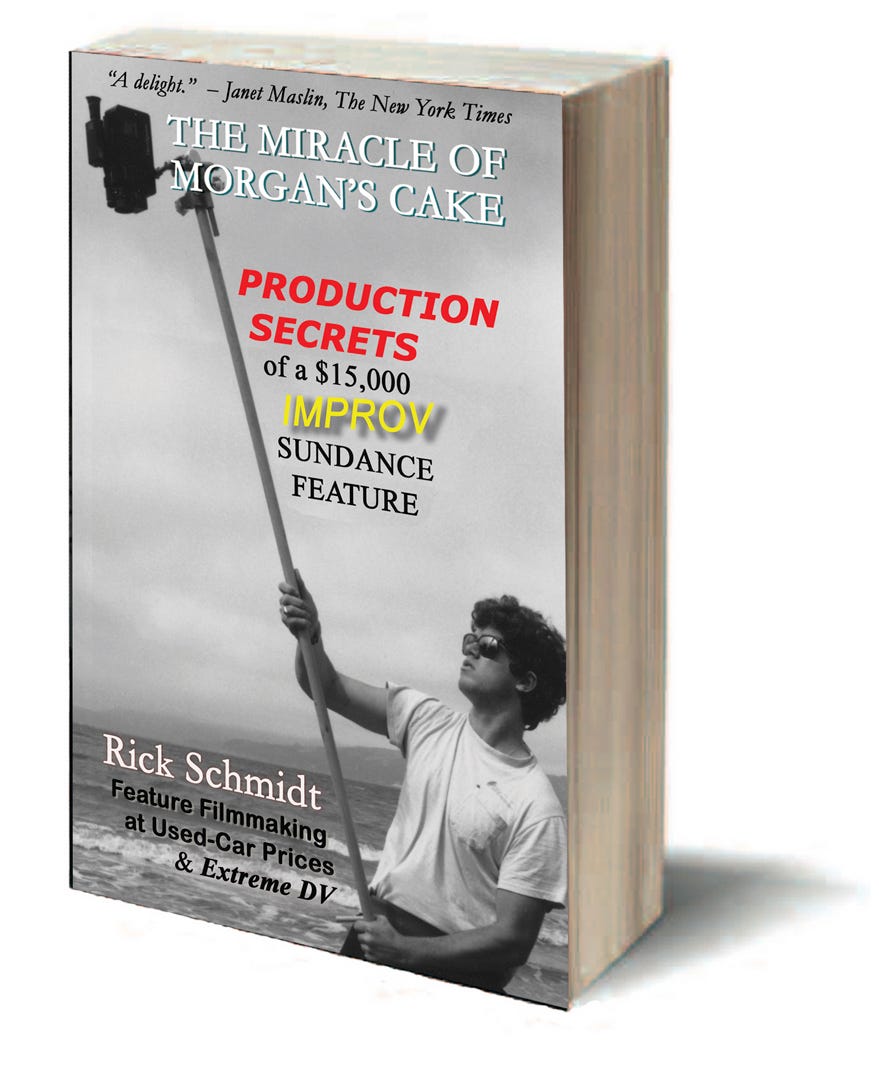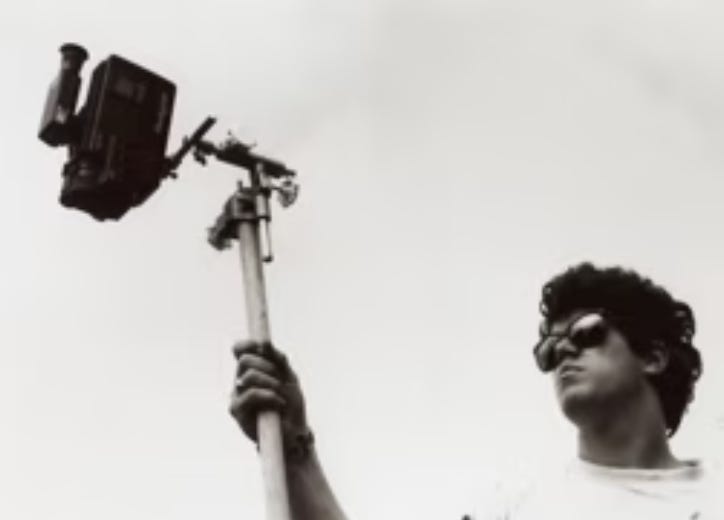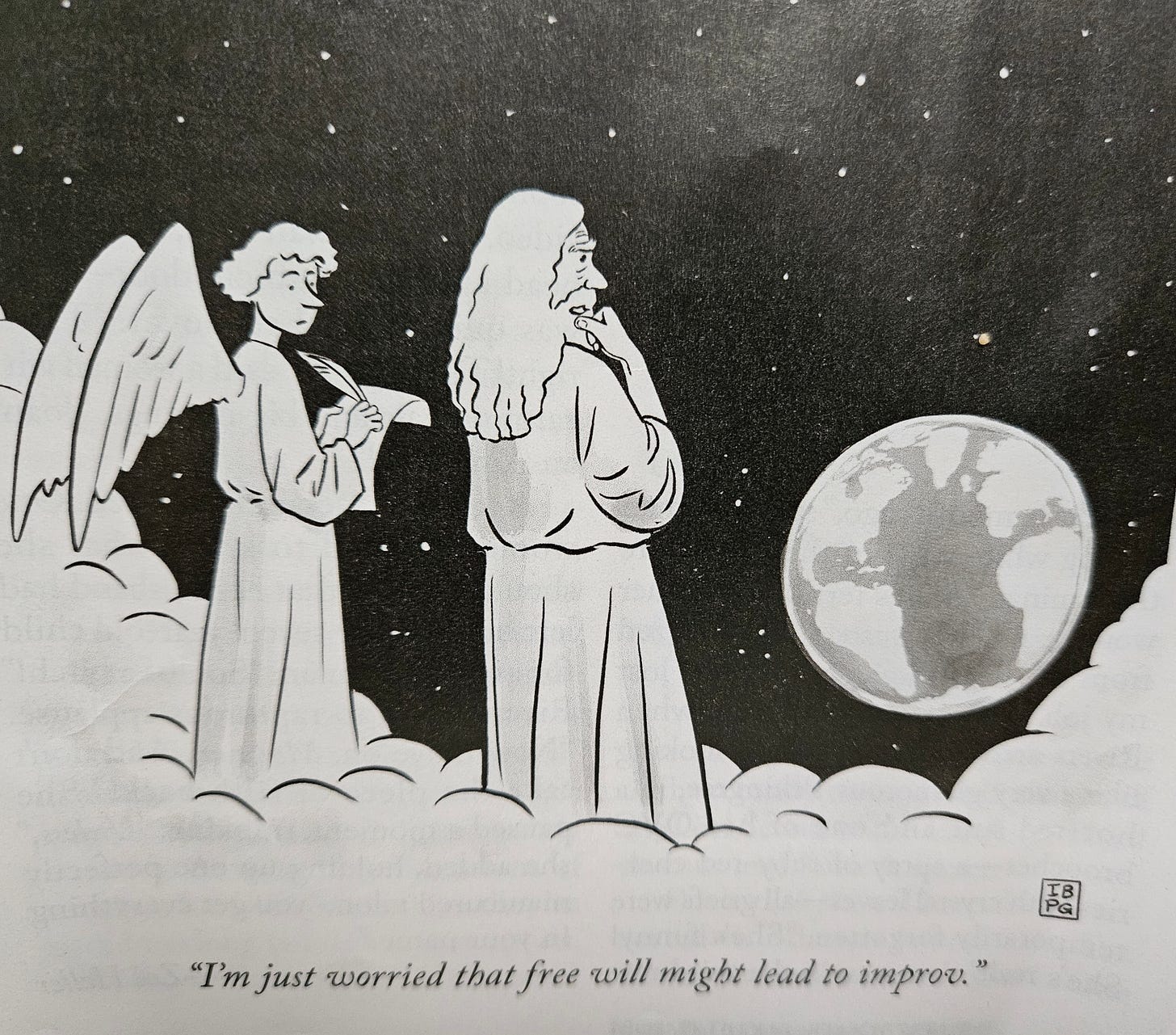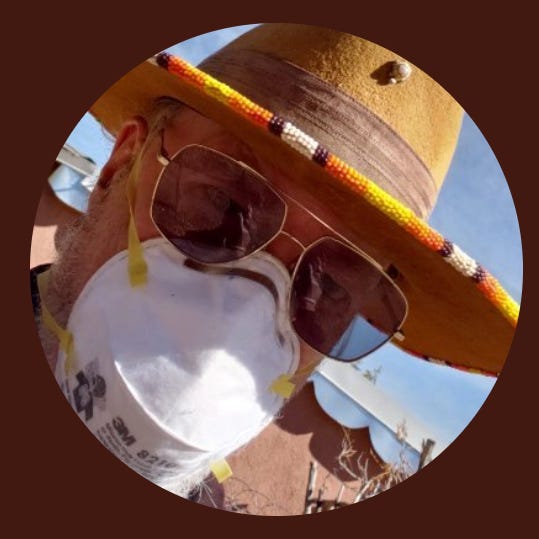"Beach scenes with camera on pole" followed Jumbo's restaurant shots--my favorite wierd images from Hi-8 video camera (footage transferred to film @$50/min.!)
https://vimeo.com/ondemand/morganscake (see TRAILER here)
(Excerpted from book, THE MIRACLE OF MORGAN'S CAKE––Production Secrets of a $15,000 IMPROV Sundance Feature").
When Morgan walked up to his father in Jumbo’s restaurant and announced, I'm going surfing, a work-worn Willie Boy Walker gave him some static about “playing around instead of earning money,” reminding his son that they had rent due by the end of the week. Morgan deftly deflected the parental barbs–I’ll get it to you. I’ll get it to you – before hastily making his escape. In the final cut, everyday customers (one in particular, nearby) can be seen eating their famous Jumbo’s hamburgers in the background, seemingly oblivious to our filmmaking activity. That tells me that we succeeded in keeping our moviemaking process low-key and invisible, like it should be if you want to catch special, real-life moments.
Although all the restaurant dialogue was improvised on the spot, I basically knew what building blocks I had to create to move the story ahead. In a sense, my previous scripting had helped to etch a story structure into my brain. I knew that (1) Willie should complain to his son about their shared rent being due, thus introducing Willie and explaining the father-son relationship, and also (2) Willie should mention to the cook or kitchen help that Morgan would turn eighteen in a week, setting up the countdown of days to the birthday party and the White House cake finalé.
When I told Willie to talk about Morgan’s upcoming birthday, the cook didn’t have to be prompted to play along. Since she was actually cooking for the lunch crowd, she repeated a real order (No onions, Bobby?), as she flipped hamburgers and waited for my voice commands. On signal, she then delivered the leading question as I had asked her to do, How old is he now, anyway? With good, intelligent actors, you will be showered with this type of dialogue gifts, people who can elaborate on your script or rough outline to improve it beyond your writing talents.
In the few minutes that remained before we’d be thrown out of the increasingly crowed Jumbo’s, I grabbed some sync- sound shots (“cutaways”) of Willie doing some kitchen work, storing washed plates under a counter, then shot him complaining to a fellow kitchen worker, Yeah, someday I’d like to take a day off too...just go to the beach.... I made a mental note to grab a shot of Morgan driving toward “the surf” after lunch, to connect up what he had told his dad and Willie’s “beach” reference. When the kitchen worker, Gus, had to make a milkshake for a customer, I shot that, recording the loud sound of the blender (in editing, I pieced this in as a nice jump cut, breaking up the flow between Morgan departing and the Willie-Gus dialogue).
For the non-writing moviemaker, there is always a way to tell a visual story using a minimum of dialogue, with words that are prompted by Voice Commands, and what’s made up on the spot. Especially with DV, moviemaking is no longer just a writer’s medium. Thinking off the top of your head and seeing great scenes and shots accumulate, you will soon gain confidence that you can create a feature-length movie without a script. And you’ll learn that your movie can include more important truth-telling than you could ever have imagined, had you used more conventional, script-based, storytelling methods.
Low-Key Directing = Realism
To me, the director of an indie movie should protect the moviemaking activity from becoming a huge attention-getting spectacle. We’ve all seen Hollywood productions take over streets with their huge, equipment-laden moving vans and mobile homes, roping off full blocks like an advancing army. I’d say it’s better to approach the creation of cinema with a quiet heart and careful concentration, focusing on the real people and their emotional states, oblivious to the artificial glitz and glamour associated with “show business.” I try to equate shooting movies to some mundane activity, like changing a tire or raking leaves in the backyard. It’s just what I do – my job in life. And I try to perform my job as best I can, just as I would do if I were a mail carrier. So, just go about your business of getting your shots with the same determination a postman does, when trying to finish his/her route by the end of the day. Or imagine a chef timing four separate orders for the same table. Skip the fanfare and glamorization of the process. That will only detract from the realism you should be after.
The way in which we basically flowed into our surroundings at Jumbo’s, made our shots fit in as part of the kitchen's daily routine, has a lot in common with what many DV filmmakers will find themselves doing with their small HD-quality cameras.
NOTE: If you have access to a radio mikes (“lavaliers”) that can be attached onto actor’s clothes and send the sound back through wireless receivers on your video camera, you’ll be way ahead of how we recorded sound with our boom pole method. In a busy restaurant you’ll want to be as inconspicuous as possible, while getting good sound. For a couple hundred dollars you can rent a top-quality lavalier. In any case, always record some ambient sound while at various locations, so you can replace your voice commands later during editing.
Cake’s Video Cut-Ins
I decided that I would next shoot an afternoon beach scene with Morgan, his girlfriend Rachel Pond, and friends Leon Kenin, and John Claudio. I had already built a simple crane for the Hi-8 video camera, using a 7' long wooden pole and a specialty swivel-bracket which soundman, Nick Bertoni, had supplied. By attaching the camera to the end of the pole, I hoped that I might be able to get a nice overhead video shot to incorporate with the 16mm beach scenes. So I got excited, imagining the movie cutting back and forth between the highly color-saturated, more grainy video images, and the clean B&W film images that comprised the main body of the movie.
For a few days leading up to the shoot I had been wondering how Morgan, a “poor kid” who lives in a tiny office with his dad, could afford to own an expensive video camera. I realized it was necessary to design a way for Morgan to logically have access to the camera, especially since I wanted to include the great Hi-8-shot draft story I’d already shot of the lone man on the street. But what was the solution?
————
A few days before the shoot, Morgan had mentioned to me that his friend, John, who lived with his uncle in a large house in the Oakland Highlands, would be willing to act in our movie. Morgan thought the uncle’s posh-looking house might serve as one of our locations. I realized then that John could represent the “rich-kid,” showing the other side of the coin from Morgan’s office-living existence. To push the “rich” element a little farther, I requested that John show up on Day-One wearing a white shirt and a vest, appearing more formal than the average teenager.
Finally, just a day before filming commenced, I had a brainstorm. What if John had the video camera on its crane pole–a rich kid strolling the beach with a fancy camera. He could meet Morgan then, while walking on the sand and, on a whim, loan it to him. Later, when Morgan goes to return the camera, we’d be able to include the upper-crust location. In preparation for the shots, I made an embossed plastic stick-on label with a phony address – “42 Crest” (to represent John’s supposed address). Now the camera and pole could be easily loaned without a long discussion about its return address.
Photo by Julie Schachter
After lunch, I decided to grab a shot of Morgan driving his Toyota truck through the Point Richmond tunnel, to a small beach just beyond. This beach, located on San Francisco Bay, was less than a half mile from Jumbo’s. In the movie you can see Rachel’s reflection in the rear view mirror and hear her and Leon’s comments about the hoped-for high surf that awaits. Since I knew there was no surf at the beach, I had the teenagers build up the idea of how BIG the surf might be (I imagined Morgan’s Cake as a mix of comedy and realism).
(From THE NEW YORKER magazine).
Once again, I hadn’t scripted exact dialogue for actors, didn’t know precisely what would happen during the upcoming scene, and certainly didn’t have any story-boarded shots or planned camera angles. But I did understand what jobs needed to be accomplished with the upcoming series of shots. We needed to (a) introduce Rachel, Leon, and John as supporting characters, (b) get the video camera into Morgan’s hands so I could incorporate the “Street Man” draft story, (c) introduce the poor vs. rich element, and (d) insure the use of John’s Uncle’s house as a location. At least I had a starting point: Morgan and friends would be gazing unhappily at the pitiful surfing conditions – no waves in sight!
To begin with, I planted Morgan, Rachel and Leon beside each other on the sand, surfboards in hand, standing tightly together to shield sound man Nick Bertoni from view of the camera. It was simply too windy to get clean dialogue recorded any other way except close-in, and a wide shot was needed for the comic effect. After allowing a bit of chatter between the group (I told them to talk about anything except the waves), Rachel blurts out, I wish we could be here before any kind of civilization. Maybe there was surf back then. Maybe reverse psychology is a good tool for moviemaking, but I hadn’t intended on using it then!
As soon as I gave John Claudio a hand signal – waved my right hand while shooting, my eye still pressed firmly against the Eclair ACL 16mm camera’s eye piece – he starting walking toward the “surfers.” As the teenagers peered out at the water, John edged into the frame, slowly moving along the tide line with the Hi-8 video camera held high above his head on the pole. I’m happy to report that the movie usually garners a laugh or two from audiences at this point, whether English speaking or not. (Sometimes good props = good laughs).
When John had crossed the entire length of the framing of Morgan’s group, I called, Freeze, and then moved the camera-on-tripod to where John had ended up. I was working fast as I always do when using the “freeze” technique, to make sure my actors did’t lose their composure. To insure that I’d have some good cut-points between the two actions, I instructed John to back up a little and prepare to retrace his steps. Before I called “action” for that reverse angle shot (Nick now huddled behind the group and surfboards, so he remained out of sight), I instructed Morgan to make some response while watching the strange guy with a video camera.
What are you doing with that thing? Morgan’s timing was perfect. His question hit when John had almost reached my tripod. John stopped, turned back toward him and answered, Making a movie about myself. Rachel piped up as well (even though I didn’t tell her to say anything), adding; How come you’ve got that thing on a stick? John answered without prompting; I don’t know...It lets me take a picture of the top of my head. Rachel was quickly becoming my secret weapon, prodding things along on her own.
OK, all good so far. But my brain was whirling. How could I engineer getting the video camera into Morgan’s hands within a few cuts? Keep in mind that I had started the Hi-8 video camera rolling when John made his initial walk into the scene, so video images were being taped throughout this entire filming session. Anyway, it was time to build a sequence of shots, shooting one-to-one (no repeat takes). Using the freeze technique I could keep shooting new pieces for cutting together later, as long as I was careful enough to overlap action and dialogue at the beginning of each new scene.
First, I told John to walk over to the group (the camera remained stationary on its tripod). As soon as he got near Morgan, I watched him slowly lower the camera down to show it off—a natural move that I hadn’t ordered (but liked!). After letting the scene run a bit I called “freeze” again, moved camera and tripod in closer to the now-four-person group, changed camera angle while thinking hard about what angle to shoot next. A quick round of dialogue prompted Morgan to try out the pole. He raised it, with everyone staring up, and after awhile I heard John say, Just bring it back next Friday...address is on the stick, before he walked away.
Yes, it was a bit of a stretch to have Morgan acquire the Hi-8 camera in this way, but for our comedic purposes the ploy worked pretty well. Once John was out of the shot – he’d disappeared to what I imagined was a chauffeur-driven car – I instructed Morgan to comment about the address on the pole. Acting “in the moment,” Morgan yells loudly, What City? What City? when he sees that there’s incomplete information on the address label. And “beach” scene was complete d (Cut!).
When I viewed the video footage afterwards, watched the overhead video shot of surf rolling in beneath Morgan’s feet, youthful and pert faces looking up into the Hi-8 camera lens, their images spinning around as the pole rotated, I was amazed that my cheap video effect had delivered such elegant footage. Later, in editing (after the video was transferred to 16mm), the juxtaposition of those color and B&W shots at the beach would create some lovely, poignant moments. When finally combined with the piano score by Gary Thorp, the scene somehow exuded both comic and tragic overtones, as if revealing the fleeting passage of youth. It’s this kind of unexpected discovery during editing that makes creating movies so much fun.
With Rachel still hanging around (I paid her and Leon $20 each per day), I next decided to shoot something on Nickel Nob hill, right up from where the beach shots had taken place, with just Morgan and Rachel on-camera. The hill offered great views of San Francisco across the Bay, and also connected up to some nice old photos I had recently uncovered at the Point Richmond Historical Society. I had considered incorporating old images of the town in the movie, and had found a great one of that same hillside, where a strange flying machine was being launched around the turn of the century. Reading the caption, I discovered that this lightweight flying contraption might have beat the Wright Brother’s attempt at manned flight at Kittyhawk, if a wind storm hadn’t knocked it over. I supplied Morgan with a thumbnail description of the event and hoped he could discuss it somewhat knowledgeably.
As our cinematographer Kathleen and sound man Nick waited patiently out of earshot, I fed Morgan one more piece of subject matter for the upcoming scene. I recounted a bizarre dream I had had the previous night, where I imagined myself somehow pregnant, with two babies growing inside my testicles. I had panicked as they became bigger and bigger. I told Morgan to first tell Rachel this dream as if it were his own, then move into the “flying machine” story. If he forgot some important part of either story, and went silent, then I would prompt him with a voice command from behind the camera.
So, with the tall wild grasses rustling in the light breeze, and the sparkling Bay in the distance, I started the camera rolling and marked the take with a clapboard for sync sound (DV is so much easier – no need for sync markers!). After a short pause before I called “action,” Morgan kissed his girlfriend, enjoyed the view, and proceeded to make my strange dream real, as his own.
NOTE: Don’t discount using the information from your dreams while the shoot progresses. Your sub-conscious mind continues to work on a movie even while you’re catching sleep. When you take the huge risk of moviemaking your mind suddenly fights against the desperation, jumping over hurdles, searching full-out for answers like a computer might do. While you sleep, it scans all the new information, double- checks past decisions and shots, busily working on new leads and connections.
Incorporating Real-Job Distractions
Before we wrapped on Day-One, Morgan somewhat sheepishly told me that he and Rachel would be unavailable to be part of the following day’s filming. What? I was immediately upset. Shit, I thought, that screws up everything! Goodbye to momentum. In my moviemaker’s mind I knew that I needed to shoot every day for at least a week, to rack up enough exposed film stock to make the feature-length movie. He could feel my temperature rising as he explained that he had this previous commitment to finish painting the bathroom at Rachel's parents' apartment. I tried to calm myself down. A part of me refused to accept this horrible news. To fortify his position, he added that her parents were angry the job had dragged on so long. That’s when I got an idea. I asked Morgan if we could just join them over there and shoot him and Rachel painting. I’d give them lines to say while they kept brushing on the paint, so the job would still get done. Everything could work out. After quick consideration Morgan agreed, and the production was back on track.








Before reading this latest Substack post, I was watching a Youtube of a psychic Medium and multiple Near Death Experiencer talking about her conviction that we each choose our lives on Earth with the intention of discovering and experiencing the knowing and expanding of our Soul and our Soul’s purpose. I know that sounds mighty “woo woo,” and perhaps it is.
But I can’t help thinking, especially after reading the final note to your post, that your Life is as good an example of what that Medium was talking about as I’ve encountered, and I’ve not been limited to just reading about it. I’ve had the good fortune to be a part of it for a time, and I couldn’t be more grateful for the part that’s played in knowing and expanding my own Soul and its purpose.
WooWooWoo!!